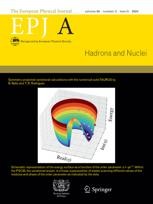THOR: Driving collaboration in heavy-ion collision research
As an expansive platform for collaboration between different research groups, the THOR COST Action has enabled hundreds of physicists studying the aftermath of high-energy collisions between heavy ions to improve their predictions
New York | Heidelberg, 3 June 2021
 In the universe’s earliest moments, particles existed in an unimaginably hot plasma, whose behaviour was governed by deeply complex webs of interaction between individual particles. Today, researchers can recreate these exotic conditions through high-energy collisions between heavy ions, whose products can tell us much about how hot, strongly-interacting matter behaves. Yet without extensive, highly coordinated collaborations between researchers across many different backgrounds, studies like this simply wouldn’t be possible. This Topical Issue of EPJ A draws together a large collection of papers inspired by the theory of hot matter and relativistic heavy-ion collisions (THOR) European Cooperation in Science and Technology (COST) Action. Running between November 2016 and April 2021, THOR has provided a way for over 300 researchers involved in heavy-ion collision analysis to freely exchange their ideas, leading to exciting new advances in the wider field of particle physics.
In the universe’s earliest moments, particles existed in an unimaginably hot plasma, whose behaviour was governed by deeply complex webs of interaction between individual particles. Today, researchers can recreate these exotic conditions through high-energy collisions between heavy ions, whose products can tell us much about how hot, strongly-interacting matter behaves. Yet without extensive, highly coordinated collaborations between researchers across many different backgrounds, studies like this simply wouldn’t be possible. This Topical Issue of EPJ A draws together a large collection of papers inspired by the theory of hot matter and relativistic heavy-ion collisions (THOR) European Cooperation in Science and Technology (COST) Action. Running between November 2016 and April 2021, THOR has provided a way for over 300 researchers involved in heavy-ion collision analysis to freely exchange their ideas, leading to exciting new advances in the wider field of particle physics.
Collisions between heavy ions have now been conducted extensively at facilities including CERN’s Large Hadron Collider, and Brookhaven National Laboratory’s Relativistic Heavy Ion Collider. Through the efforts of the THOR COST Action, collaborations between researchers encompassing a broad range of skill sets have led to innovative new ways to analyse the data gathered by these experiments. Interpreting the aftermath of a heavy-ion collision requires extremely precise statistical analysis – involving techniques ranging from foundational microscopic theories, to computer simulations of real collisions. Inevitably, such a wide array of approaches has generated an expansive network of interrelated results in literature.
The THOR COST Action was founded on the idea that the predictions provided by theories and simulations could be improved upon, by creating a platform for researchers across this network to freely communicate their results. This has enabled the physicists participating in the project to improve their methods, based on the outcomes of other studies taking completely different approaches. Over its 4-year run, THOR has supported 73 Short Term Scientific Missions, involving 301 researchers overall. In addition, the project has placed a strong emphasis on encouraging participation from students, providing unprecedented training opportunities for a future generation of experts.
All articles of the Topical Issue on Theory of Hot Matter and Relativistic Heavy-Ion Collisions (THOR), edited by G Aarts, J Aichelin, M Bleicher, E Ferreiro, L Tolos, B Tomášik (2021) are available here and are freely accessible until 31 July 2021. For further information, please read the Editorial.
Reference: Aarts, G., Aichelin, J., Bleicher, M. et al. Theory of hot matter and relativistic heavy-ion collisions (THOR). Eur. Phys. J. A 57, 175 (2021). https://doi.org/10.1140/epja/s10050-021-00466-z
Further Information
For more information visit: www.epj.org
Services for Journalists
The full-text article is available here.
Contact
Sabine Lehr | Springer | Physics Editorial Department
tel +49-6221-487-8336 | sabine.lehr@springer.com
